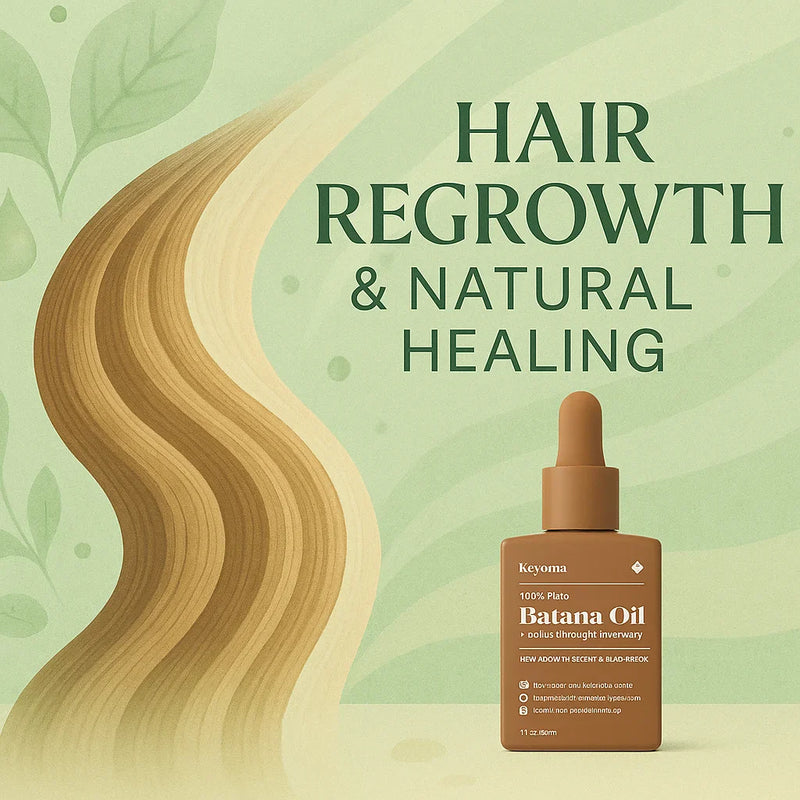Last updated
Aug 17, 2025
How Long Does It Take to Regrow Hair? Timelines and Natural Solutions
Published on
Aug 17, 2025

In this article
If you’ve ever walked out of a salon with a cut you didn’t want, chances are you pulled out your phone and searched, “How fast does hair grow?” I’ve been there too, hoping for some quick fix. The truth is, while the rate of growth is different for everyone, your hair won’t get longer overnight.
It’s easy to lose patience when you’re waiting months for shorter strands to catch up. I remember checking my hairline in the mirror every week after a chop I regretted, wishing it would grow faster. You probably know that restless feeling too.
On average, hair grows about half an inch a month. That sounds small, but it adds up if you stay consistent with healthy habits. The process might feel slow, but you’re not stuck waiting without options.
You can take steps that support stronger, healthier growth. Simple things like giving your scalp more attention, eating the right foods, or choosing gentle products make a difference.
Keep on reading to understand how growth works, what influences the pace, and what you can do to help your hair grow in thicker and healthier over time.
Key Takeaways
-
Hair grows about half an inch per month on average, adding up to roughly six inches a year.
-
Growth speed varies by factors like age, ethnicity, and health, and it often slows after age 30.
-
Recovery timelines differ: stubble shows within days after shaving, weeks after waxing, months after chemotherapy, and within six months for telogen effluvium.
-
Healthy habits such as balanced nutrition, gentle care, scalp massage, and avoiding harsh treatments support stronger and steadier growth.
How Hair Growth Works

Our hair grows from tiny openings in your skin called follicles. You have about 5 million of them across your body, with close to 100,000 sitting on your scalp alone.
Each strand moves through different phases.
-
Anagen is the active growth stage, and it can last anywhere from 2 to 8 years. Most of the hair on your head is in this phase right now.
-
Catagen comes next. Growth stops during this stage, and it lasts around 4 to 6 weeks.
-
Telogen is the resting stage, where hair doesn’t grow or fall. That pause usually lasts 2 to 3 months.
-
Exogen is when the shedding happens. Hair falls out during this stage, and it can go on for 2 to 5 months. I’ve noticed this most when I find strands on my pillow or in the shower drain.
Only about 5 to 10 percent of the hair on your scalp sits in the telogen phase at any given time, which explains why you don’t notice constant shedding.
The cycle works the same way on the rest of your body, but it wraps up in about a month. That’s why your arm or leg hair stays short while your scalp hair has time to grow long.
How Long Does It Take to Regrow Hair?
Hair actually grows faster than you might think. The American Academy of Dermatology reports that scalp hair adds up to about six inches a year, which works out to roughly half an inch each month. That number is an average though, so your results might be a little different.
How much growth you see depends on your hair type. If your hair is curly, half an inch of new growth can look like almost nothing compared to the same amount on straight hair. I’ve noticed that myself—when my curls are tight, the progress feels invisible until I stretch them out.
Texture changes the way growth looks, but the timeline doesn’t change. Whether your hair is straight, wavy, or coily, the rate stays the same.
Hair Regrowth Timeline After a Haircut
Your hair grows at its own pace, and a lot of that comes down to factors like age and ethnicity. A 2016 study of more than 2,000 young adults broke it down pretty clearly.
-
Asian hair grows around 0.49 inches a month, which adds up to nearly 6 inches a year.
-
Black hair averages closer to 0.33 inches a month, or about 4 inches annually.
-
White and Latino hair typically grows about 0.44 inches a month, adding up to just over 5 inches each year.
To put that into perspective, if your hair once reached past your shoulders and you cut it into a short bob, you’d wait years for it to return to its old length. I remember cutting mine into a blunt bob once—it felt stylish for a month, but the wait to grow it out again tested my patience.
Growth also slows after age 30, so if you’re in that stage of life, it’s normal to notice progress feels slower than it used to.
How Fast Hair Grows Back After Shaving or Waxing
When you shave, you cut the hair at the surface. The root stays in place, so growth starts right away. That’s why stubble usually shows up within a day or two. I notice it on my legs almost overnight.
Waxing works differently. It pulls the entire root from beneath the skin. Because of that, it can take close to two weeks before stubble even appears. Most people schedule their next wax somewhere between three and six weeks, depending on how fast their hair grows. I’ve found that once you get into a routine, the regrowth feels softer and easier to manage.
How Long to Regrow Hair After Chemo
Your hair often needs a few weeks to recover after treatment before it starts growing again. Most people see new growth within 3 to 6 months once the treatment ends.
When it comes back, don’t be surprised if it looks a little different at first. I’ve seen friends go through this, and the changes usually don’t last.
Your new hair might feel softer, come in curlier, or even look slightly darker or lighter. Sometimes it grows in gray until the pigment cells kick back in. It can feel strange, but over time your hair usually returns to its familiar texture and color
Regrowth Timeline After Telogen Effluvium
Telogen effluvium happens when many of your hair follicles shift into the resting phase at the same time, but the next growth phase doesn’t kick in. As a result, hair sheds all over your scalp without new strands replacing it. I’ve seen people describe it as sudden thinning rather than bald patches, which makes sense since the loss is spread out.
This condition often follows a major event. Common triggers include:
-
Childbirth
-
Surgery
-
High fever
-
Starting and stopping certain medications like birth control
It usually shows up about three months after the trigger. Your hair might look noticeably thinner, but you won’t lose it all. The good news is it’s reversible. Once your body recovers or the trigger is resolved, growth often restarts within six months.
For some, though, shedding can linger for years. That part can feel frustrating, but knowing the cause helps you set realistic expectations while you wait for your hair to bounce back.
How Long Does Hair Grow Back After Hair Transplant
Instead of checking the mirror every morning for signs of new growth, it helps to know what the hair transplant timeline looks like. Here’s a month-by-month breakdown so you know what to expect and when.

First Month After Transplant
During the first two weeks, focus on healing. You won’t see new growth yet, and that’s completely normal. What matters most is following your surgeon’s aftercare directions—how to wash your scalp, how to sleep, when to exercise, and which medications to take.
When I’ve seen people skip steps here, their recovery took longer. Taking care now makes sure both the donor and transplanted areas heal properly, setting you up for lasting results.
You might notice shedding after two to three weeks. This “shock loss” stage can feel alarming, but it’s a routine part of the process. The follicles stay healthy; it’s only the strands that fall.
2 to 3 Months After Transplant
Shedding often continues through the first few months. Your scalp might look patchy, and it’s easy to feel discouraged. I’ve heard friends say this was the hardest stage, but it’s temporary and part of the recovery.
Learn how to differentiate hair shedding vs hair loss
3 to 6 Months After Transplant
Here’s where things shift. Fine, soft hairs start to come through. At first they’re wispy, but they thicken over time.
6 to 8 Months After Transplant
By six months, growth usually looks fuller. You’ll notice more density and stronger texture compared to those early, delicate strands.
8 to 12 Months After Transplant
This is often called the maturation period. The follicles settle into their natural rhythm, and growth looks thicker and more even. By the one-year mark, most people see hair that blends naturally with the rest.
Long-Term Results After One Year
At this point, your results have set in. Both the donor and transplanted areas have healed, and the new hair grows like your own. Many people say this stage finally gave them the confidence they were waiting for.
How to Support Faster, Healthier Regrowth
You can’t make your hair grow faster overnight, but you can take steps to keep it stronger and reduce shedding. Small changes in your routine add up over time. Here are some ways to support healthier growth.

Eat a balanced diet with plenty of protein, iron, and vitamin C. I’ve noticed my hair feels stronger when I stay consistent with meals instead of skipping them.
-
Talk with your doctor before adding supplements. Iron, folic acid, biotin, omega-3s, omega-6s, and zinc can help if you’re low, but there’s no benefit in doubling up if you already get enough from food.
-
Avoid harsh treatments and limit heat styling. I once used a flat iron daily, and the breakage took months to repair.
-
Skip tight hairstyles that pull on your roots.
-
Massage your scalp when you shampoo. It improves blood flow to your follicles and feels relaxing too.
-
Use natural hair treatments like batana oil, castor oil, rosemary oil, and other plant-based solutions to avoid harsh side effects.
-
Choose sulfate-free shampoos and conditioners, especially ones with vitamin E or keratin. If you have scalp conditions like psoriasis, a dermatologist can recommend medicated options.
-
Trim your ends every 6 to 8 weeks to keep split ends from traveling up the hair shaft.
-
Consider topical treatments like minoxidil if you’re looking for extra support.
-
If you smoke, reducing or quitting helps your circulation and your hair. A doctor can guide you through a plan that works for you.
-
Protect your hair from too much sun by wearing a hat.
If you want quick cosmetic fixes while waiting for growth, wigs or extensions can help. For more permanent solutions, hair transplants are also an option.
Restore Hair Naturally with Keyoma Batana Oil
Hair growth takes time, and the process depends on many factors like age, health, and lifestyle. Whether you are waiting for a haircut to grow out, recovering after a medical treatment, or managing conditions like telogen effluvium, patience and consistent care are key.
Healthy habits such as eating nutrient-rich foods, protecting your scalp, and avoiding harsh styling make a real difference in how strong and resilient your hair becomes over time.
While medical options and cosmetic fixes exist, starting with gentle, natural treatments helps you nourish your scalp and strengthen strands from the root up.
Keyoma Pure Batana Oil with Rosemary provides essential fatty acids and antioxidants that support healthier regrowth, reduce breakage, and promote fuller-looking hair. Making it part of your routine is a simple step toward restoring your hair’s natural strength and confidence.
Featured Product
100% Pure Batana Oil + Rosemary
Learn more about Batana Oil
Your Cart
Your Cart is empty
Let's fix that
You might like...
Search our store








